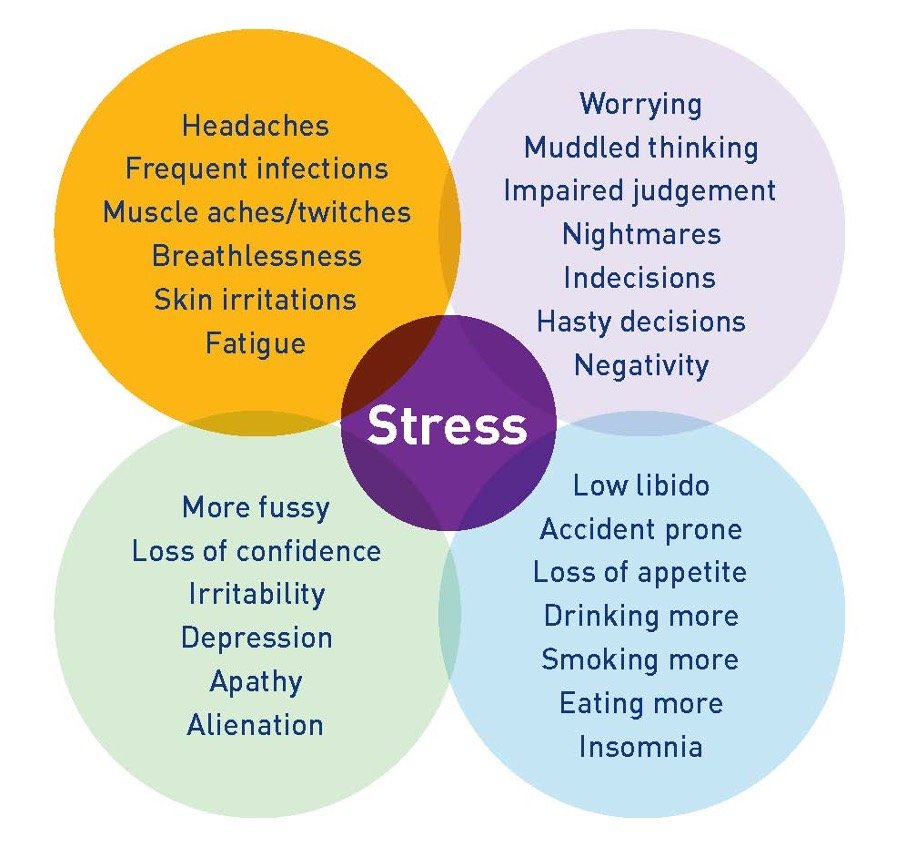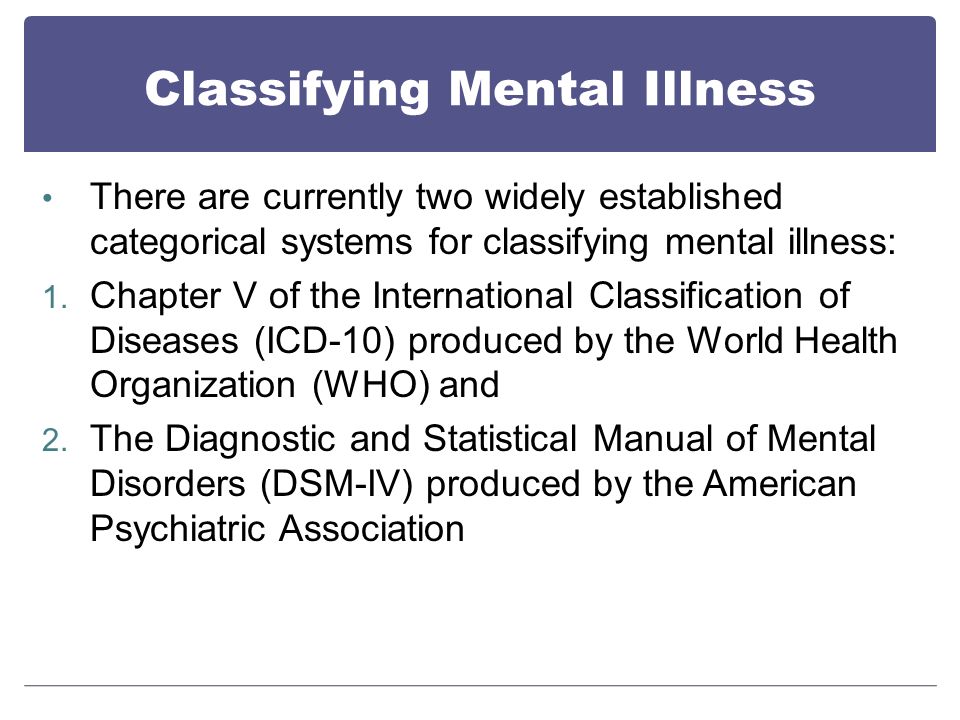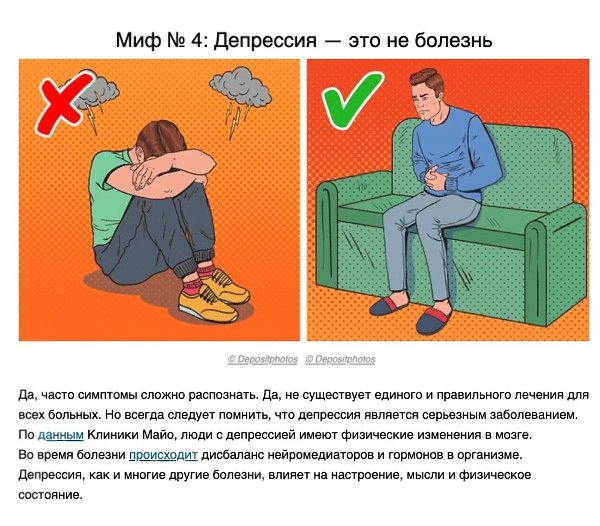Reasonable accommodations for adhd
Attention Deficit/Hyperactivity Disorder (AD/HD)
About Attention Deficit/Hyperactivity Disorder (AD/HD)
Attention deficit-hyperactivity disorder (AD/HD) is a neurobehavioral disorder that affects three to five percent of American children and adults. AD/HD is usually diagnosed in childhood, and the condition can continue into the adult years. Many individuals with AD/HD are undiagnosed until adulthood.
The common characteristics of AD/HD are impulsivity, inattention, and/or over-activity. Failure to listen to instructions, inability to organize oneself and work tasks, fidgeting with hands and feet, talking too much, inability to stay on task, leaving projects, chores and work tasks unfinished, and having trouble paying attention to and responding to details are the primary symptoms of AD/HD. Although individuals may have both inattention and hyperactivity symptoms, many individuals predominantly display one symptom more than another. There are three subtypes of AD/HD:
- AD/HD predominantly hyperactive-impulsive type: The major characteristics are fidgeting, talking excessively, interrupting others when talking, and impatience.
- AD/HD predominantly inattentive type: The major characteristics are distractibility, organization problems, failure to give close attention to details, difficulty processing information quickly and accurately, and difficulty following through with instructions.
- AD/HD combined type: The individual with combined type meets the criteria for both hyperactive-impulsive and inattentive type.
Attention Deficit/Hyperactivity Disorder (AD/HD) and the Americans with Disabilities Act
The ADA does not contain a definitive list of medical conditions that constitute disabilities. Instead, the ADA defines a person with a disability as someone who (1) has a physical or mental impairment that substantially limits one or more "major life activities," (2) has a record of such an impairment, or (3) is regarded as having such an impairment. For more information about how to determine whether a person has a disability under the ADA, see How to Determine Whether a Person Has a Disability under the Americans with Disabilities Act Amendments Act (ADAAA).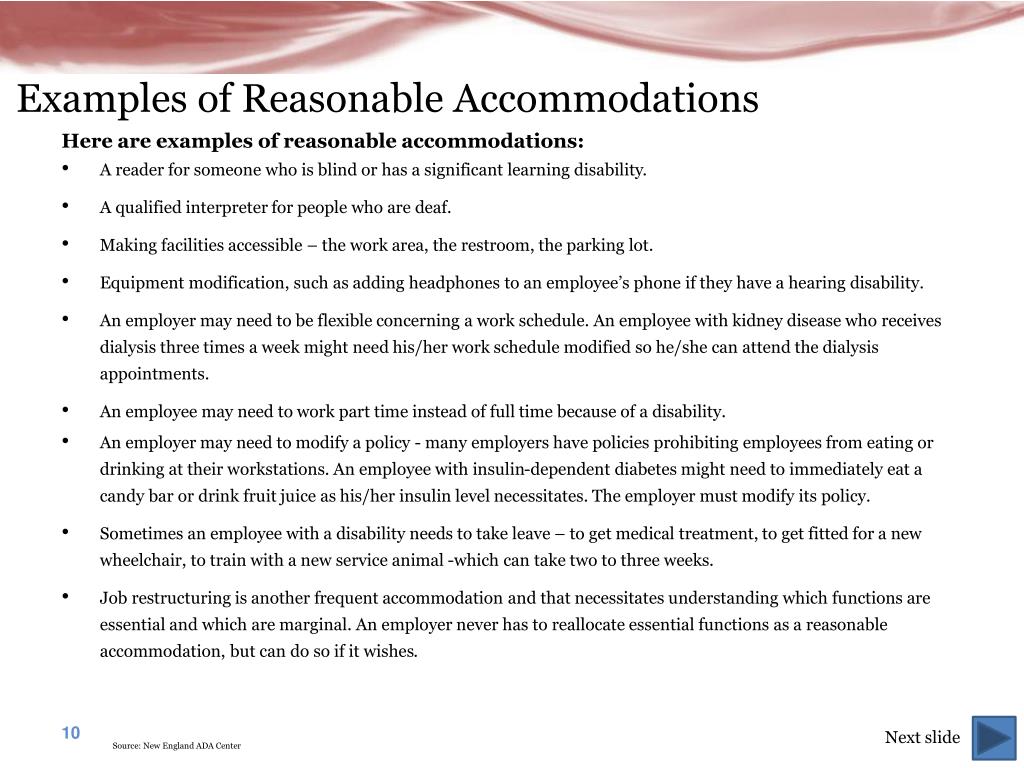
Accommodating Employees with Attention Deficit/Hyperactivity Disorder (AD/HD)
People with AD/HD may develop some of the limitations discussed below, but seldom develop all of them. Also, the degree of limitation will vary among individuals. There are some general accommodations that explain how people with AD/HD disregard themselves at work.
General: Individuals with AD/HD are often perfectionists and are hard on themselves. They have trouble setting personal boundaries like knowing when to stop working and they set unrealistic expectations for themselves. Someone who takes work home or stays late to finish work is often given more responsibility or a heavier workload because they appear to be able to get their work done. General accommodations include:
• Help identifying strengths instead of focusing on weaknesses
• Reinforcing creativity
• Pointing out any signs that the individual is overworked – not taking vacations, staying at work late frequently, not eating lunch
• Providing an AD/HD coach to suggest ways to increase productivity and maintain a healthy work-life balance
JAN's Accommodation Solutions: Executive Functioning Deficits is a publication detailing accommodations for individuals with limitations related to executive functioning.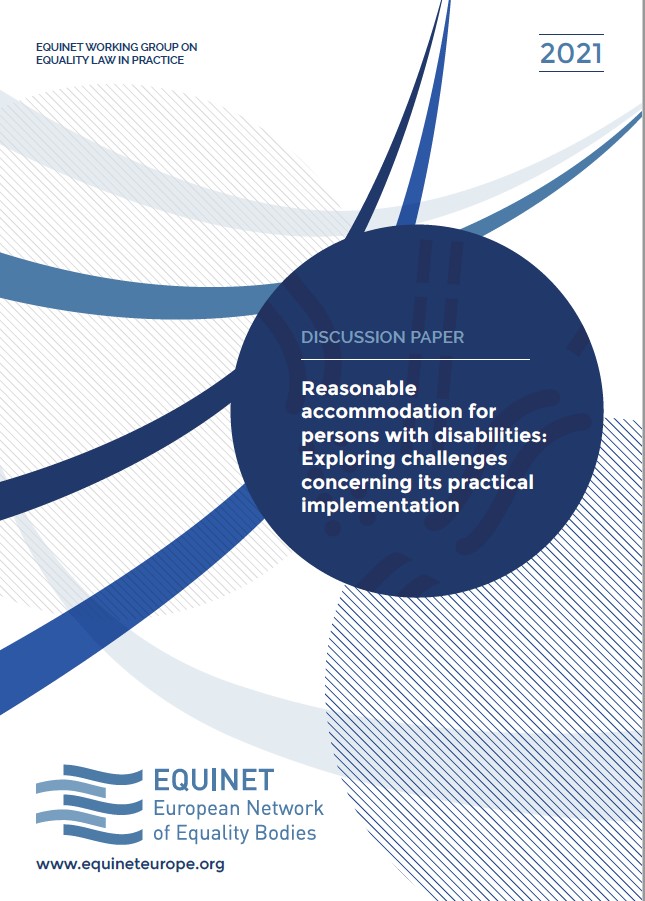 These ideas may be helpful in determining accommodations. Be aware that not all people with AD/HD will need accommodations to perform their jobs and many others may only need a few accommodations. The following is only a sample of the possibilities available. Numerous other accommodation solutions may exist.
These ideas may be helpful in determining accommodations. Be aware that not all people with AD/HD will need accommodations to perform their jobs and many others may only need a few accommodations. The following is only a sample of the possibilities available. Numerous other accommodation solutions may exist.
Questions to Consider:
- What limitations is the employee experiencing?
- How do these limitations affect the employee and the employee’s job performance?
- What specific job tasks are problematic as a result of these limitations?
- What accommodations are available to reduce or eliminate these problems? Are all possible resources being used to determine possible accommodations?
- Once accommodations are in place, would it be useful to meet with the employee to evaluate the effectiveness of the accommodations and to determine whether additional accommodations are needed?
- Do supervisory personnel and employees need training?
Key Accommodations:
Hyperactivity/ Impulsivity: For individuals with AD/HD, accommodations for hyperactivity/impulsivity might be beneficial.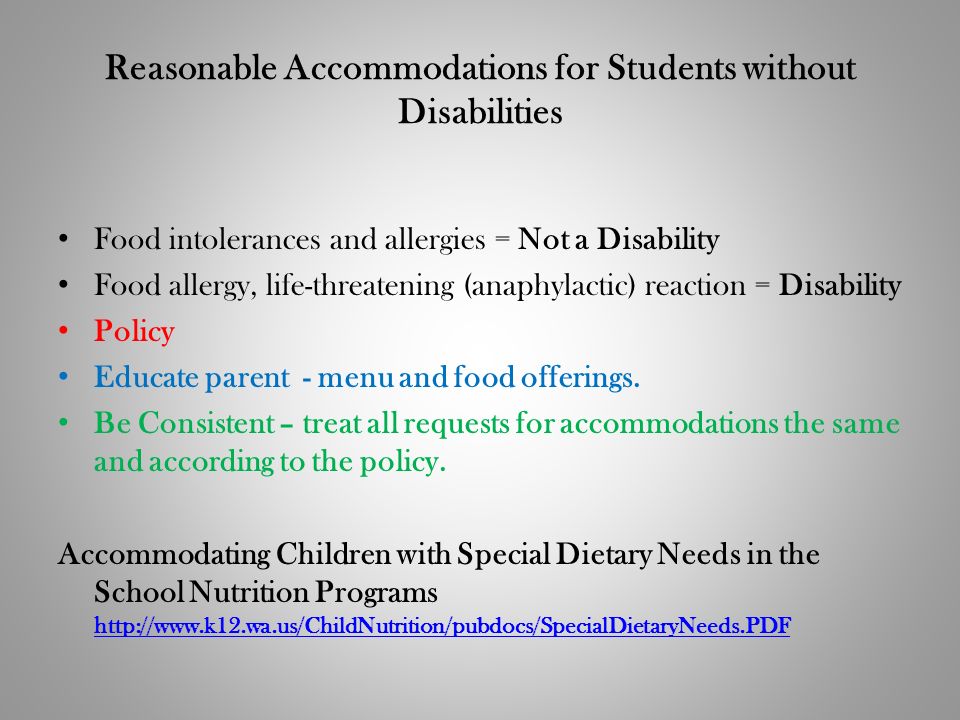
- Provide structured breaks as a physical outlet
- Utilize a job coach to teach/reinforce techniques
- Allow the employee to work from home
- Review conduct policy with employee
- Adjust method of supervision
- Use services of EAP
- Provide private workspace
Focus/Concentration: For individuals with AD/HD, accommodations minimizing distractions might be improve performance.
- Provide a quiet work space
- Allow use of noise cancellation or white noise
- Work from home if no effective accommodations in office environment
- Uninterrupted work time
- Taking allotted breaks as needed
- Minimizing marginal functions to allow focus on essential job duties
Time management: For individuals with AD/HD, accommodations assisting with staying on task is often helpful
- Assign a mentor
- Provide to-do lists
- Meetings to discuss expectations
- Assistance with prioritization
- Assistive technology (timers, apps, calendars, etc)
Strategies for the Individual with the disability
Getting to Work on Time: For individuals with AD/HD, getting to work on time can often be difficult.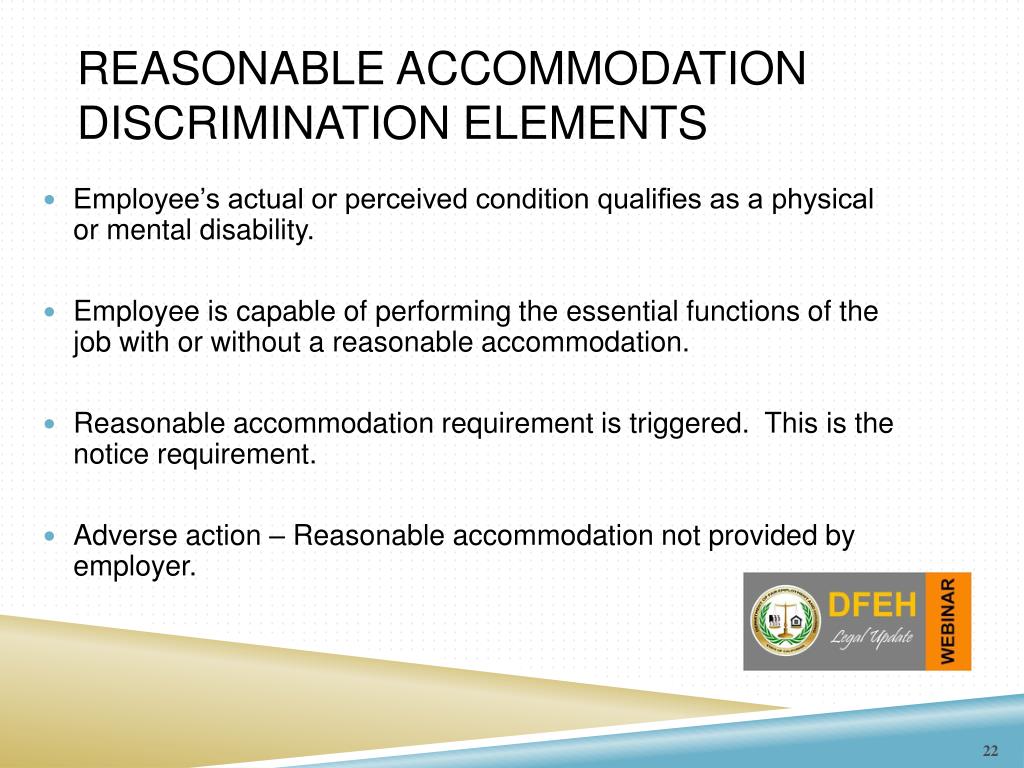
- Have a routine of putting/keeping things in place
- Prepare for the next day’s work the night before
- Create checklists for yourself and others
- Place sticky notes where you will see them
- Turn off distractions – including cell phones
- Use a timer or programmable watch to pace self
Accommodation Ideas:
By Limitation
Attentiveness/Concentration
Disruptive Behavior
Executive Functioning Deficits
Managing Time
Memory Loss
Multitasking
Organizing/Planning/Prioritizing
Social Skills
Stress Intolerance
Situations and Solutions:
The following situations and solutions are real-life examples of accommodations that were made by JAN customers. Because accommodations are made on a case-by-case basis, these examples may not be effective for every workplace but give you an idea about the types of accommodations that are possible.
A delivery person with AD/HD had difficulty with time management.
She spent excessive time making deliveries and would forget to return to the warehouse between daily runs. The employer provided a personal organizer watch that could be programmed to beep and display a written message many times throughout the day. This auditory and written prompt helped the employee move quicker from task to task, and helped remind her to return to the warehouse to gather her next load.
A journalist with AD/HD experienced sensitivity to visual and auditory distractions.
The employer provided the individual with a private, high-wall cubicle workspace in a low-traffic area. The employer added an environmental sound machine to mask office noise.
A part-time college professor with AD/HD was having difficulty planning new courses he had yet to teach when the schedule changed quickly and he was required to do so under tight time constraints.
He asked JAN how that could be accommodated.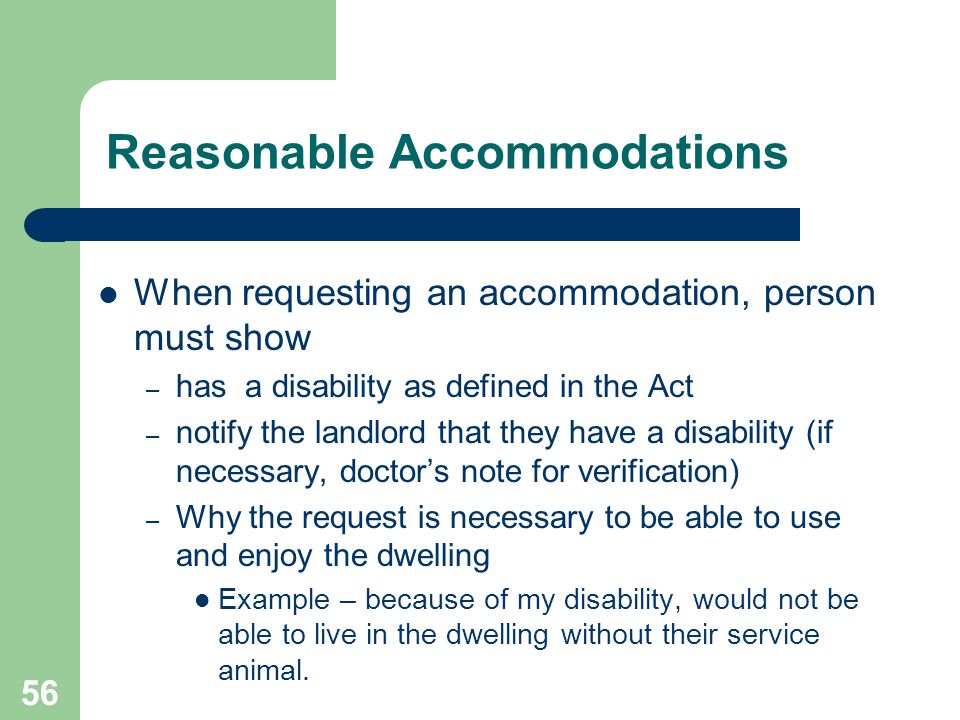 A consultant at JAN recommended he request that he only be put on the new courses that were firmly scheduled ahead of time in order to give him time to prepare. If he were to teach courses that were suddenly added, he asked that those be ones he had previously taught and planned for.
A consultant at JAN recommended he request that he only be put on the new courses that were firmly scheduled ahead of time in order to give him time to prepare. If he were to teach courses that were suddenly added, he asked that those be ones he had previously taught and planned for.
An employee in a management position has been successful in his position for quite some time but when a new supervisor comes on board, the standards for written communication are more strictly enforced.
The employee, who has AD/HD, has difficulty attending to detail. This includes spelling, grammar, and punctuation errors in his written communications that go out to employees and business partners alike. The employee was accommodated with speech recognition software that allowed him to dictate whatever he needed to write. A playback feature allows him an added layer of oversight. He also requested writing/editing software that he can plug his written materials into so they will be checked over for spelling, grammar, and punctuation an additional time.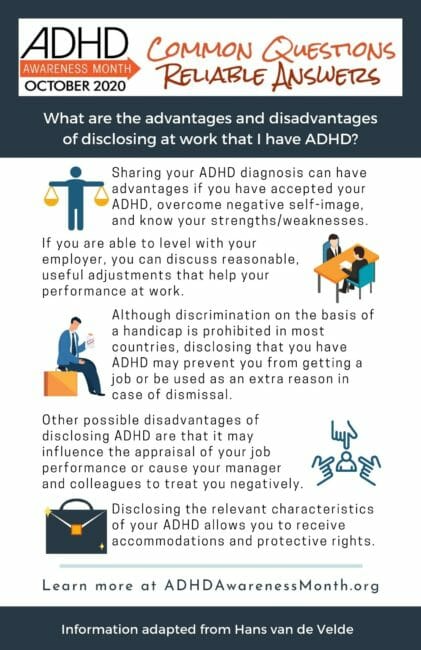
A retail employee with AD/HD often forgot the closing and cash-out procedures, which resulted in missed printouts of daily sale reports.
The employer created a numbered checklist that identified each step for proper closing procedures and identified which reports to run from cash registers. This accommodation benefited all employees.
An office worker with AD/HD experienced impulsivity and often interrupted co-workers by entering offices without knocking.
The employer helped identify appropriate techniques for approaching co-workers, such as keeping a daily list of tasks to discuss with others, then emailing or calling to set aside time to talk about work-related projects.
A retail employee with AD/HD often forgot the closing and cash-out procedures, which resulted in missed printouts of daily sales reports.
The employer created a numbered checklist that identified each step for proper closing procedures and identified which reports to run from cash registers. This accommodation benefited all employees.
This accommodation benefited all employees.
A social worker with AD/HD had difficulty completing handwritten paperwork in a neat and timely fashion.
The employer created electronic forms for the employee, which allowed him to type responses. The employer arranged computer files labeled by month to help the employee prioritize open cases. The employer also sent e-mail reminders of deadlines.
A teacher with AD/HD experienced disorganization in her classroom due to clutter from many years of teaching.
The employer provided a job coach to help the teacher learn organization techniques, to help separate and store items, and to dispose of previous student work and projects from yesteryear.
Asking for Workplace Accommodations - CHADD
ADHD Weekly April 18, 2019
You love your job, your coworkers are pleasant, and your boss doesn’t make impossible demands. Yet your ADHD symptoms make it hard to keep papers organized while you’re juggling project details.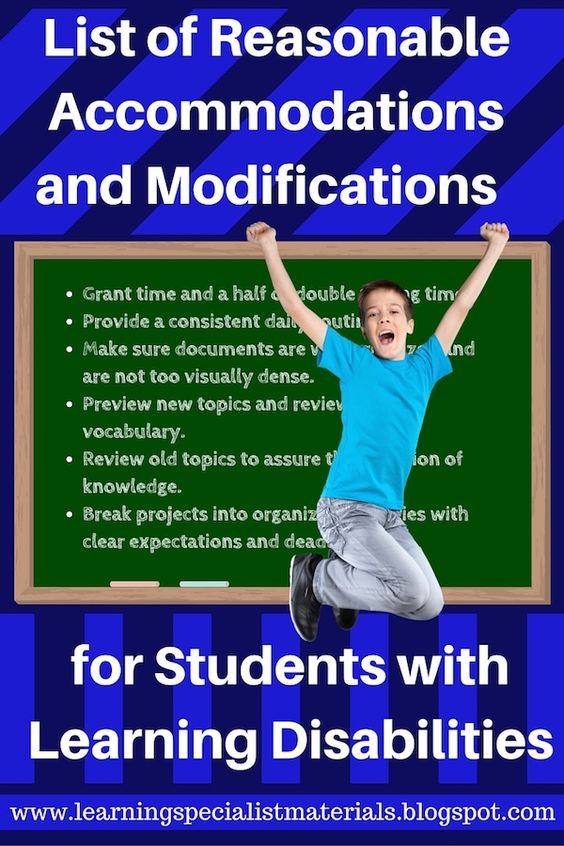 Workplace noise and the busy atmosphere distract you, and you can’t get your work done in a reasonable amount of time.
Workplace noise and the busy atmosphere distract you, and you can’t get your work done in a reasonable amount of time.
You’re worried about your future. You don’t need to leave. You may be able to fix what isn’t working for you in your workplace.
The Americans with Disabilities Act
In 1990, Congress passed the Americans with Disabilities Act of 1990 to improve access and create accommodations for people with various disabilities. The ADA includes ADHD as a recognized disability. For an employee who has ADHD, the act can require the employer to provide reasonable accommodations, as long as it doesn’t create undue hardship for the business.
Not everyone who has ADHD is a “qualified individual” according to the ADA, says Nancy O’Mara Ezold, an employment lawyer and partner in the Philadelphia-based Ezold Law Firm.
“If a person has ADHD but it doesn’t substantially limit any major life activity, then they’re not going to be qualified under the ADA for any help,” she says.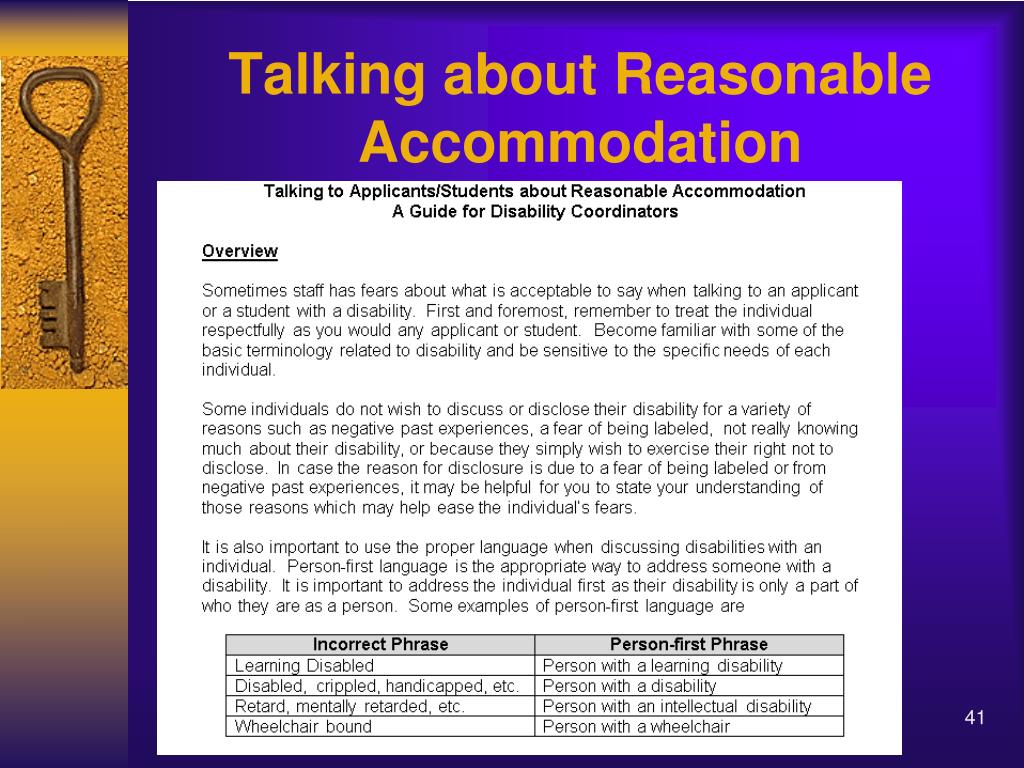
If you do qualify, it could mean that if you can’t get work done because of noise, you might be able to ask for a private office with a door. If that’s not possible, placing your desk in a non-central location, where fewer people will pass by, is a reasonable accommodation.
When to disclose a diagnosis
You don’t have to disclose that you have ADHD when you’re interviewing for a job. On the flip side, if your ADHD symptoms get in the way of your work, don’t wait too long.
“A lot of times people disclose that [they have ADHD] a little too late—after they’ve been put on probation. At that point, it probably doesn’t help,” says Elias Sarkis, MD, founder of Sarkis Family Psychiatry and Clinical Trials and past president of the Florida Psychiatric Society.
When you do share your diagnosis, mention the positives that apply to you: are you creative, an outside-the-box thinker with a lot of energy? Can you focus on a task that grabs your interest for a long time? Share with your employer the strengths you bring that can improve the company or help it reach its goals.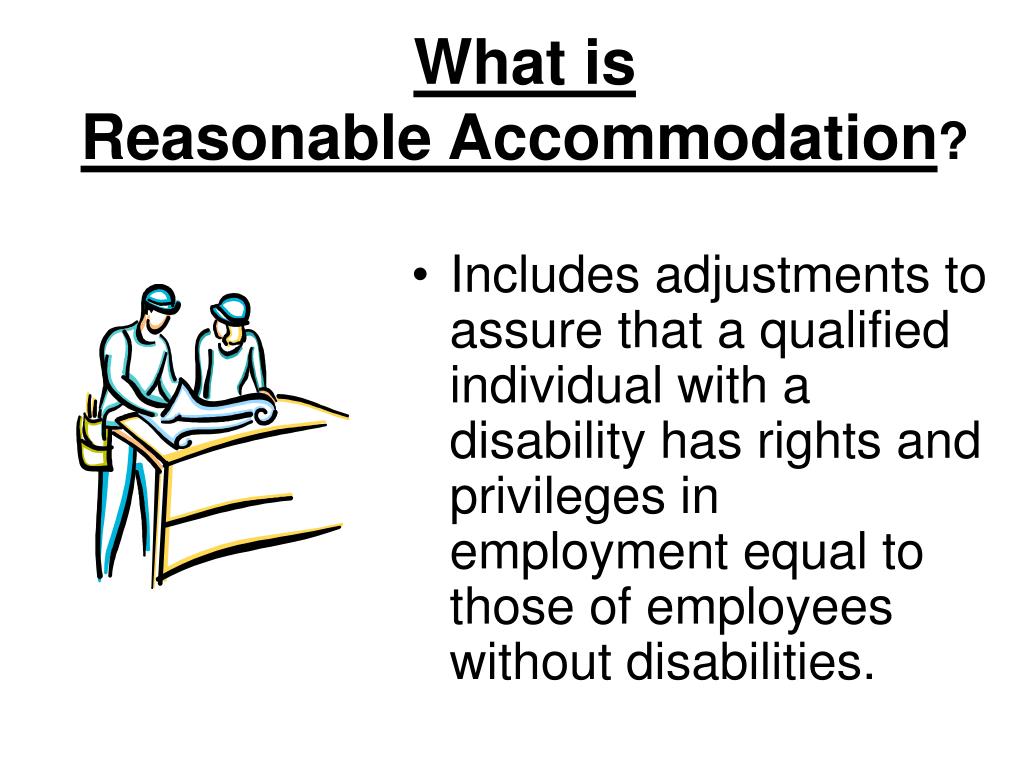
Asking for accommodations
Ms. Ezold says most people experience one of three scenarios:
- No problem getting the job done despite having ADHD
- Wanting to request accommodations but not disclose an ADHD diagnosis
- Needing to disclose an ADHD diagnosis and request accommodations
In the first situation, there’s no need to share the ADHD diagnosis since it is not affecting the ability to complete work successfully. Often someone in this scenario can find tricks and tips to manage ADHD symptoms in the workplace without involving an employer.
Someone in the second situation might approach his manager and say something like, “The noise in the room really distracts me—is it okay for me to wear earphones while I’m working?” or “It’s distracting to me being so close to the elevator, with everyone coming and going. Would it be possible for me to move to that empty desk in the back corner?” That kind of request is general and there’s no need to say anything about ADHD.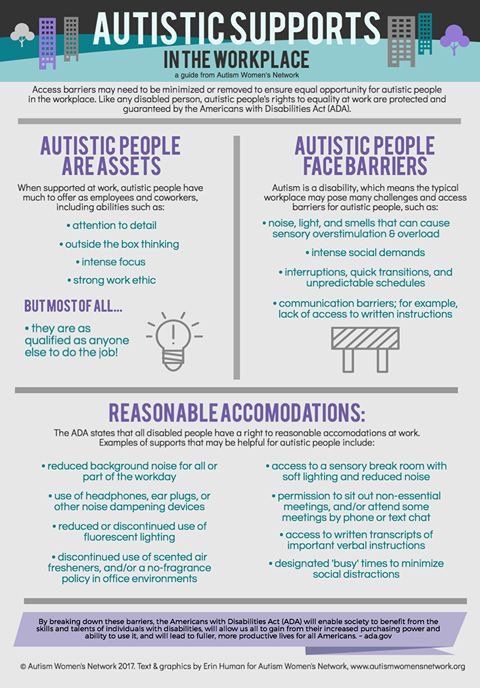 Yet you may decide you need to disclose your diagnosis when asking for more specific accommodations. You’ll want to be sure to share how making these small changes will improve your productivity.
Yet you may decide you need to disclose your diagnosis when asking for more specific accommodations. You’ll want to be sure to share how making these small changes will improve your productivity.
When an employee cannot meet the requirements of the position because of ADHD symptoms, however, disclosure is often necessary. He needs to first assess whether the job is a good fit, confirming he would be successful with a few changes. If he decides it’s the conditions and not the job, he should consider carefully what accommodations he needs to be successful.
“Are there accommodations that can be helpful?” asks Dr. Sarkis. “It’s pointless to disclose if you’re not going to be able to get any accommodations, or if they aren’t going to be helpful.”
Dr. Sarkis says he meets many salespeople with ADHD who interact well with other healthcare providers but struggle to complete their paperwork. A suggestion in that case might be to ask for an administrative assistant to help.
Ms.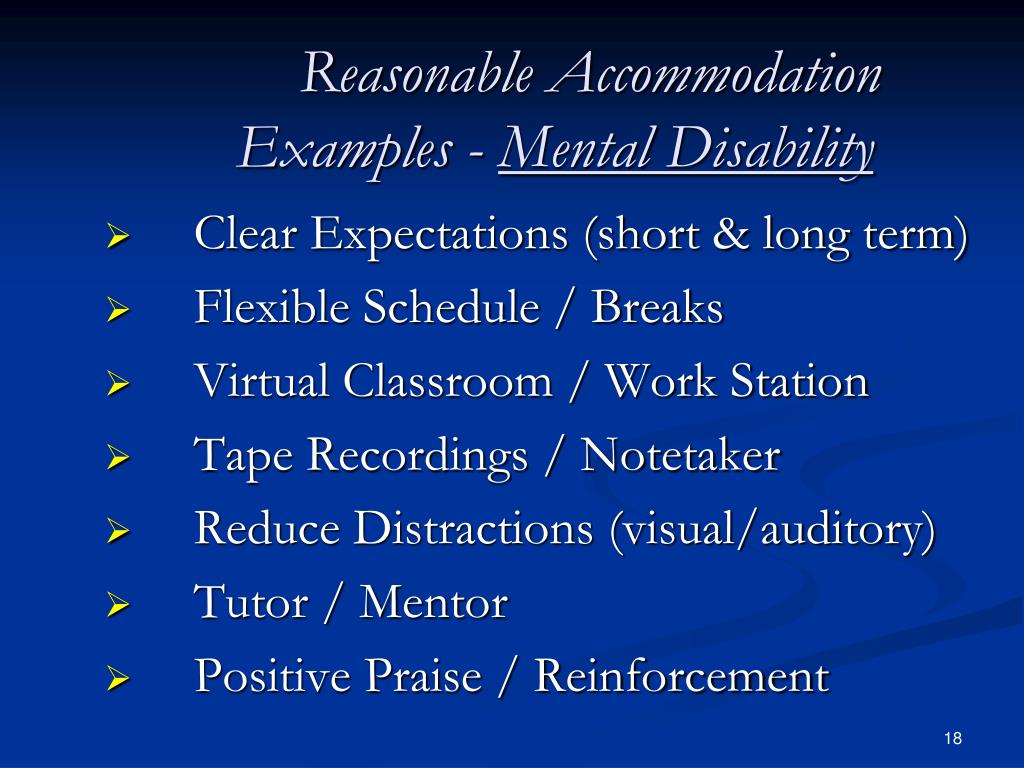 Ezold recommends discussing your needs with your human resources department, if you have one. Let the HR officer know you have ADHD and how it’s affecting you, and then discuss ways to resolve those issues so you can do your job well. Go to the meeting with two or three realistic suggestions for changes. You may also have to provide a written confirmation from your doctor that you have a disability and any recommended accommodations. Your employers need to know exactly what they’re responding to and what the limitations of your disability are. It benefits both of you if you’re clear about yours.
Ezold recommends discussing your needs with your human resources department, if you have one. Let the HR officer know you have ADHD and how it’s affecting you, and then discuss ways to resolve those issues so you can do your job well. Go to the meeting with two or three realistic suggestions for changes. You may also have to provide a written confirmation from your doctor that you have a disability and any recommended accommodations. Your employers need to know exactly what they’re responding to and what the limitations of your disability are. It benefits both of you if you’re clear about yours.
When to get help talking with your employer
The ADA states that as long as you are capable of meeting the “essential functions” of the job, you are entitled to help. If you haven’t yet spoken with your supervisor, and you think he or she is reasonable and understands what needs fixing and how it can be done, that’s a good place to start.
If you’ve tried every option, or your employer is pushing back, you may need to contact a workplace advocate or an attorney.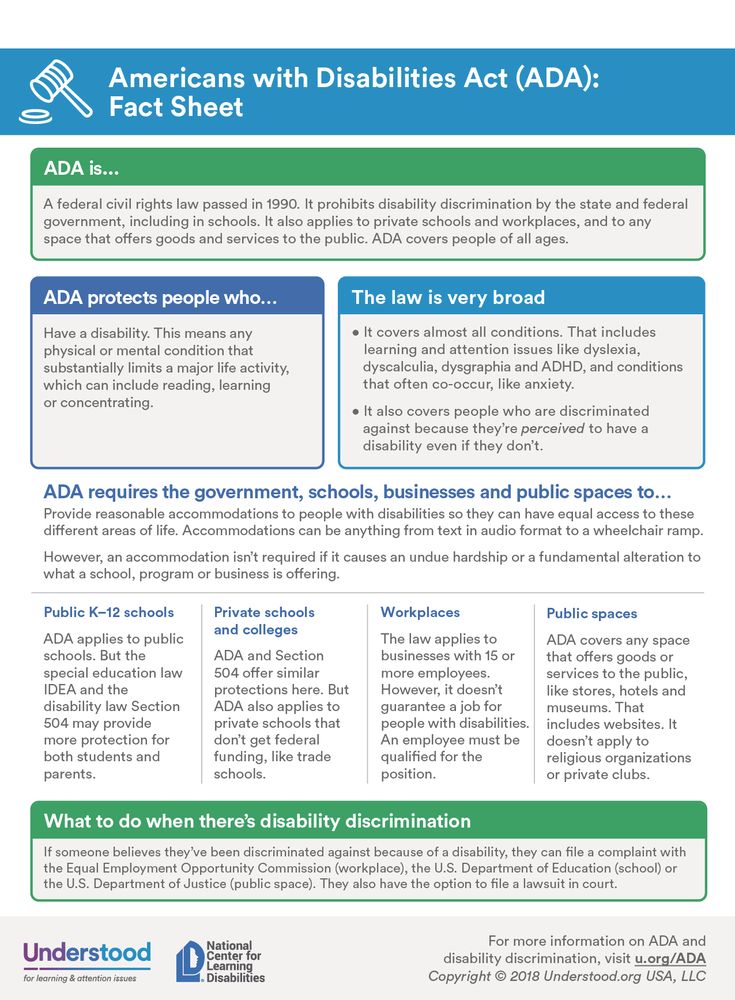 Ms. Ezold says that’s definitely the way to go if your employer says your request is “unreasonable.”
Ms. Ezold says that’s definitely the way to go if your employer says your request is “unreasonable.”
“I call it leveling the playing field,” she says. “Any employee in the workplace who is up against the whole HR department by themselves and is not getting the recognition or the respect they deserve has got to have help.”
Dig deeper into this topic:
- Job Accommodation Network. If you have a question about workplace accommodations or the ADA and related legislation, call them.
- Succeeding in the Workplace
- Workplace Accommodations Can Make You and Your Employer More Successful
- Workplace Accommodations: I Can Ask for Those?
- Talking with Employers
- What Works for You in the Workplace?
- Americans with Disabilities Act
- Enforcement Guidance: Reasonable Accommodation and Undue Hardship Under the Americans with Disabilities Act
Join the discussion: Have you successfully received accommodations for your ADHD at work?
10 WAYS TO HELP A CHILD WITH ATTENTION DEFICIENCY WITH HYPERACTIVITY
1.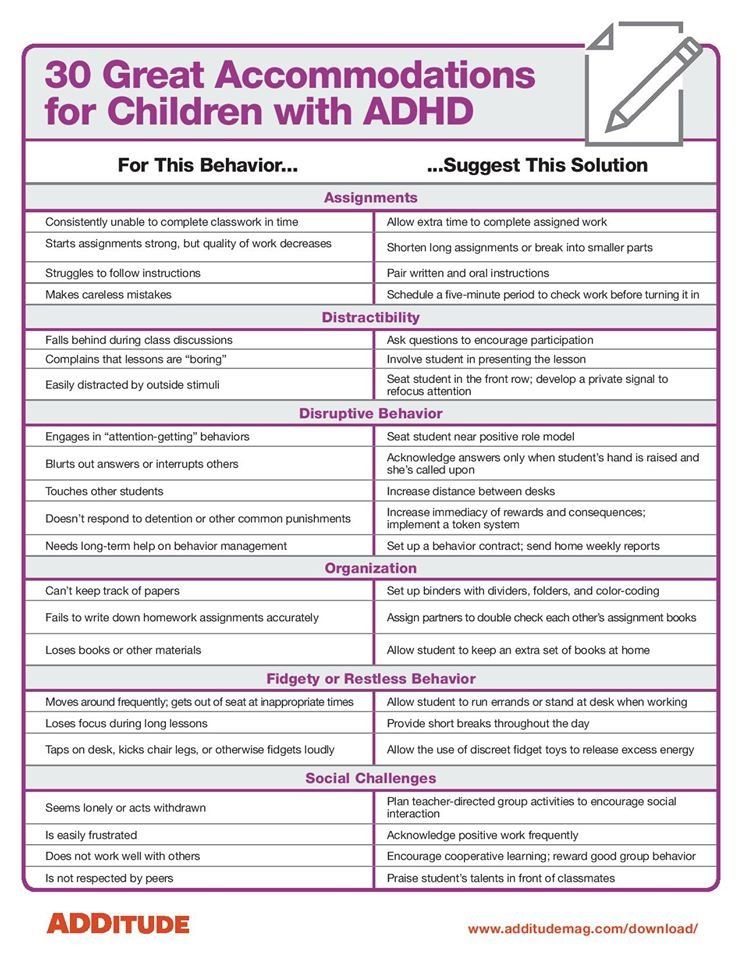 Remove distractions
Remove distractions
activities and sounds from the street can distract the child's attention. That's why it's so important the right calm environment during classes. You can offer for a child with ADHD, mobile partitions on the table, desks, earplugs, luminous glasses filter. This will reduce susceptibility to external stimuli. Also effective means are inflatable balancing discs for sitting, which reduce the creak of chairs when the student sits on them.
2. Constantly train your sense of balance
The areas of concentration and balance are so closely related that more and more new devices are steadily emerging so that the child can practice and at the same time maintain body balance in a changing environment. Use all sorts of ways to develop your balance skills. It doesn't have to be complicated bungee jumps or obstacle courses in play centers or playgrounds. Moreover, the best period for practicing balance is the time immediately before the lesson.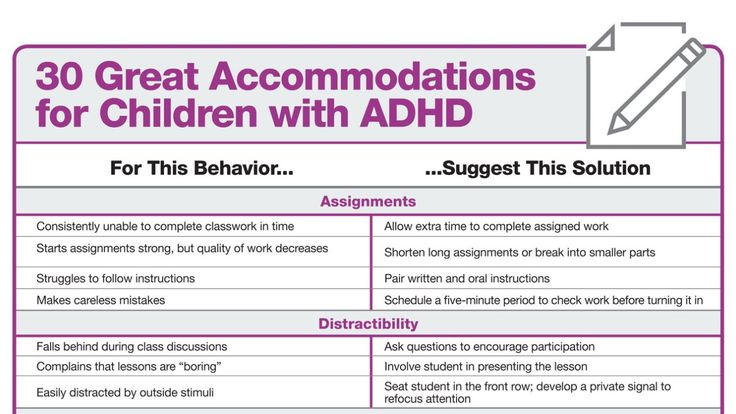 There are many tools for training balance at home, among which are those that are used during exercise at the table. Large fitness ball, trampoline, balancing board, inflatable balancing hemisphere, stretching table legs for balancing legs while sitting. The key word in balance training is CONSTANTLY.
There are many tools for training balance at home, among which are those that are used during exercise at the table. Large fitness ball, trampoline, balancing board, inflatable balancing hemisphere, stretching table legs for balancing legs while sitting. The key word in balance training is CONSTANTLY.
hand-eye coordination
Toss and catch, but not the ball, but light scarf (!) It is much easier for the child, but the therapeutic effect remains pronounced. Just 5 minutes before any activity that requires concentration of attention, and you will be surprised at the positive result!
4. Correct table position and posture
what is the posture of the child during classes, plays an important role in readiness his body to efforts to focus attention. Use a reclining seat chair, or a special seat stand - with air inside. It leads child in a state of increased attention due to the active inclination to the table and over him.
Also an effective way to long reading can become a bean bag chair that gently works with proprioceptive sensitivity, providing the child with complete information about position of his body, thereby removing external stimuli (from not understanding “where self" that children with ADHD or ASD often experience).
5. Weights and pressure
Sensory weight system leads to a decrease in response to external stimuli and releases power to focus. Vests and belts with weights are at your service, as well as a weighted knee pillow.
6. Sensory activity breaks
when the child either ran aimlessly, or remained sitting at a table or desk. Fill breaks in activity with different sensory impact.
These may be games with touch boxes, in the sand, with water, with a bag containing your favorite sensory toys child (rosary, toy soldiers, boxes). Or distraction with maximum benefit for gross motor skills - a children's sports corner, a hammock or a bean bag in as a felting mat. Such breaks refresh the child's ability to focus. attention.
7. Vibration
Any vibration massage or self-vibration exercise for older children. It awakens the attention, tones the body and improves concentration in the next period.
8. Chewing
swallow it. Or the use of improvised means that can be sucked, chew, bite. Or special devices akin to a teether for kids.
Every opportunity to chew for a child with ADHD can be tried as a way to focus. AND sometimes it is simply amazing how the child's ability to concentrate on task only because he was allowed to chew during class.
9. Take your hands, including drawing more often everything and everything from paints and felt-tip pens, to deprive the child of the opportunity to draw it is forbidden. Thus, you block his path to improving his ability focus attention. Small devices for busy people are also at your service. hands - rosaries, elastic bands, sponges, plasticine - in general, everything that gets over, crumples, twists, stretches and easily transforms in other ways.
10. Deep breathing
Soap bubbles of all are at your service formats and any wind instruments - from a whistle and a pipe to a mouthpiece harmonicas. For confidence in progress in the development of your child, we want to remind you that SKILL FOCUS is a skill that CAN BE LEARNED. Enough like small but daily steps to practice concentration, and your child will show clear progress for a long time time.
Attention deficit hyperactivity disorder (ADHD)
What if some mental disorders are not disorders at all?
What if mental disorders such as anxiety, depression or post-traumatic stress disorder are not mental disorders at all? In a new paper, biological anthropologists are calling on the scientific community to rethink mental illness. After careful study, they provide information that allows you to think of depression or post-traumatic stress as a reaction to adversity, rather than a chemical imbalance. And ADHD may be a way of functioning that has evolved in a hereditary environment that doesn't fit the way we live today.
Adaptive response to adversity.
Mental disorders are usually treated with drugs within the medical model. So why do the anthropologists who wrote this study argue that these disorders may not be medical at all? They point to several key points. First, medicine has never been able to prove that anxiety, depression, or post-traumatic stress disorder (PTSD) are inherited conditions. Second, the authors of the study note that despite the widespread and growing use of antidepressants, levels of anxiety and depression are not improving. From 1990 to 2010 the global prevalence of depressive disorder and anxiety disorders was 4.4% and 4%. At the same time, data continues to show that antidepressants work no better than placebo. Thirdly, worldwide, the incidence of these disorders remains stable at 1 in 14 people. However, in conflict-affected countries, approximately one in five people suffer from depression, post-traumatic stress disorder, anxiety and other disorders.
Collectively, the authors suggest that anxiety, depression, and post-traumatic stress disorder may be adaptive responses to adversity. Defense systems are devices that are reliably activated in threatening situations to minimize losses. It's not hard to see how this relates to anxiety - it helps us avoid danger. But how does this relate to depression? Scientists claim that the mental pain of depression helps us focus on adverse events in order to mitigate current adversity and avoid similar adversity in the future. If this does not inspire confidence in you, then consider that neuroscientists are increasingly relegating these three disorders to branches of the threat detection system. Anxiety can be caused by chronic activation of the fight or flight system. Post-traumatic stress disorder can occur when an injury triggers a freeze response that helps animals switch off from pain before death, and depression can be a chronic activation of the same freeze response.
Labels matter.
Labels are what help define who we are and what we are capable of. Too often labels limit us. That's why it's important to rethink how we treat anxiety, depression, or ADHD. Does anyone have depression, a brain disease, or a suppressed adaptive response to adversity? Adversity is something we can overcome, while mental illness must be fought. Labels offer a variety of possibilities.
Let's talk a little about ADHD. A generation ago, boys with ADHD were called bad boys and punished or detained. We are now helping children with ADHD understand that they have learning differences. Instead of detention, we try to provide support in a variety of ways. When we do this, behavior problems often disappear. This re-labeling of learning difference is vital because it gives children with ADHD the opportunity to be good and succeed. However, ADHD is still an Attention Deficit Hyperactivity Disorder. In Finland, where a lot of physical activity is part of the school day, rates of ADHD are very low. Meanwhile, in Russia, children are asked to sit quietly for most of the day. Primary school students often only get 15-20 minutes of break per day. And as a result, ADHD rates have risen over the past 15 years.
The authors of the study state that ADHD is not a disorder. Rather, it is an evolutionary mismatch with the modern educational environment that we have created. If ADHD is not a disorder, but a mismatch with the person's environment, then it is not a medical problem. This is a question of education reform. And that's a compelling thought, given the evidence that physical activity improves children's concentration and cognition. However, we must take this study with a grain of salt. There is a large body of research showing other biological factors associated with ADHD. For example, there is evidence that preterm birth further increases levels of ADHD.
Social reform or treatment?
The authors of the study compared the treatment of anxiety, depression or post-traumatic stress disorder with antidepressants with the treatment of a broken bone without fixing the bone itself. They believe that these problems are more like socio-cultural phenomena, so the solution is not necessarily to correct dysfunction in the human brain, but to correct dysfunction in the social world. This is a fair criticism of how we treat mental illness. But the stated goal of the article is not to change treatment, but to explore new ways to get rid of these problems. Research on depression, anxiety, and post-traumatic stress should focus more on mitigating conflict and adversity and less on manipulating brain chemistry.
Based on this, do we need to change the way we view mental health? Yes and no. When it comes to what labels we use, the change is welcome. Mental health recovery depends in part on whether patients believe they will get better. Telling patients that their symptoms may be related to a healthy response to adversity can be very reassuring. It's not news to doctors that adversity affects mental health. But until reform removes the social causes of suffering, physicians should continue to provide patients with standard care.

